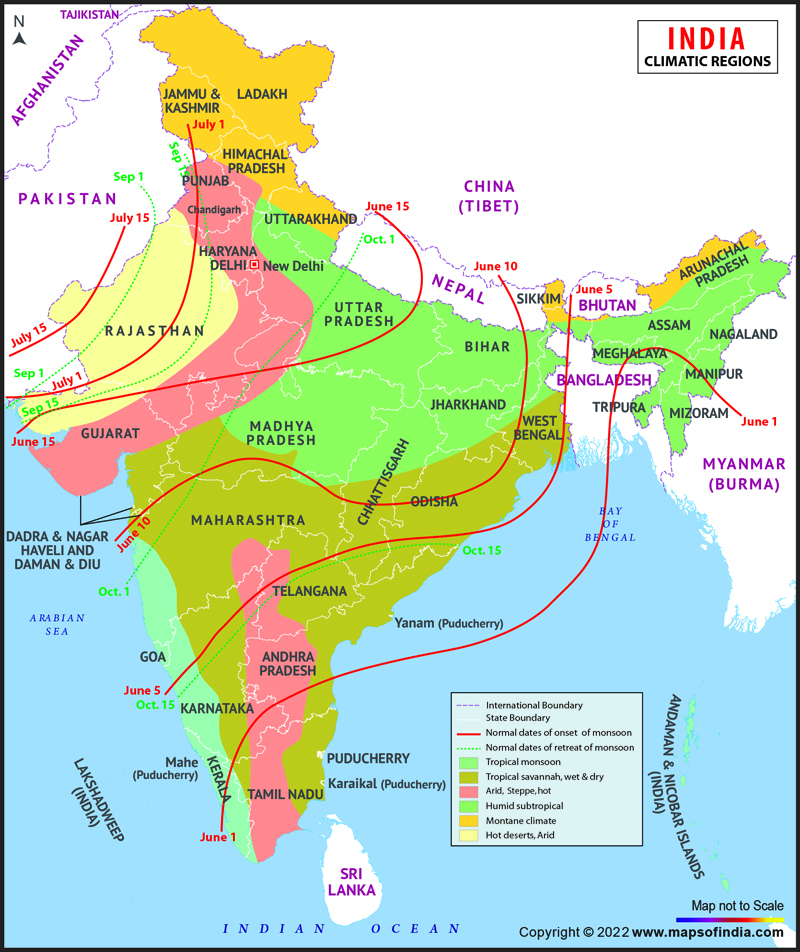Different Types of Climatic Regions
The climates of India are mainly divided into four different groups. The classification of these groups is based on the Koppen climate classification system.
- Tropical Wet (Humid): The tropical wet (humid) climate group in India is divided into two subparts - tropical monsoon climate or the tropical wet climate, and tropical wet and dry climate or savannah climate. The Western Ghats, the Malabar Coast, southern Assam, Lakshadweep and Andaman and the Nicobar Islands have the tropical monsoon climate. It experiences moderate to high temperature with seasonal but heavy rainfall. The months from May to November experience the most rainfall and the rain received during this period is sufficient for vegetation throughout the year. Tropical wet and dry climate or the savannah climate is most common in the country. It prevails mainly in the inland peninsular region of the country except for some portion of the Western Ghats. The summers are scorching and the rainy season extends from June to September.
- Tropical Dry: The tropical dry climate group is divided into three subdivisions (a) tropical semi-arid (steppe) climate, (b) sub-tropical arid (desert) climate and (c) sub-tropical semi-arid (steppe) climate. Karnataka, central Maharashtra, some parts of Tamil Nadu and Andhra Pradesh experience the tropical semi-arid (steppe) climate. Rainfall is very unreliable in this type of climate, and the hot and dry summers are experienced from March to May. With scanty and erratic rainfall and extreme summers, western Rajasthan witnesses the sub-tropical arid (desert) climate. The areas of the tropical desert that runs from the regions of Punjab and Haryana to Kathiawar witness the sub-tropical semi-arid (steppe) climate. The maximum temperature in summers goes up to 40°C, and the rains are unreliable and generally take place during summer monsoon season in this climate.
- Sub-tropical Humid Climate: This climate is witnessed by most of the North and Northeast India. Summers are scorching, while in winters, the temperature can plunge to as low as 0°C. Rainfall mainly occurs in summers, but snowfall or occasional rain in winters is also witnessed in some areas. The hottest months are May, and June and frost also occur for few months in winters.
- Mountain Climate: The temperature falls by 0.6°C for every 100 m rise in altitude in the Himalayas and results in several different climates from tropical to tundra. The trans-Himalayan belt, which is the northern side of the western Himalayas, is cold, arid and windswept. There is less rain on the leeward side of the mountains whereas the well-exposed slopes receive heavy rainfall. The heaviest snowfall occurs between December to February.
Seasons of India
India generally witnesses four types of seasons. During these seasons, substantial variations in temperature take place in the country. The different types of seasons experienced in India are as follows:
- Winter: Generally, the months of January and February are considered as the start of the winter season in the country. However, in some parts of north-western India, the season begins from December. Generally, the average temperature during this season is about 10-15°C in northwest regions. In the southeast region of mainland India, the average temperature is about 20-25°C. The western Himalayas, the extreme north-eastern parts and Kerala and Tamil Nadu, experience rains during this season.
- Summer/Pre-monsoon/Thunderstorm/Hot Weather:The country experiences this season from March till June. In the interior peninsular regions, the mean daily temperature is recorded at 30-35°C. The maximum temperature in the daytime in Central India crosses 40°C in many areas. In some regions, the temperature is high during daytime while in the nights, low temperature is recorded. The coastal areas of the country have mild temperature during this season due to the influence of land and sea breezes. Thunderstorms with rains and hail influence the weather in the land areas of the country. These thunderstorms are seen in the north-eastern and eastern parts of Bihar, Assam and West Bengal. In the plains of northwest India, hot and dry winds, along with dust winds, are frequently experienced.
- Rainy/South-west Monsoon (WS Monsoon): The months from July to September are the most significant. The monsoon torrents supply about 75% of the total rainfall of the country during this season. The exact period of the SW monsoon in a region depends upon the onset and withdrawal time of the season. For instance, it remains in west Rajasthan for about 75 days while it stays for 120 days in the south-western regions of the country. The SW monsoon reaches in two branches: the Arabian Sea and the Bay of Bengal branch. The Arabian Sea branch extends towards the low-pressure area over the Thar Desert and is about three times stronger than the Bay of Bengal branch. The northern hemispheric temperatures, El Nino, snow cover, sea surface temperature and many others are some of the local and global phenomena which influence the monsoons in the country. The SW starts to weaken by September 1 in Rajasthan and from September 15 in some north-western parts of the country. The monsoons in India are very important for the economy of the country as it affects agriculture which is the mainstay of a massive workforce of the nation.
- Autumn/Post Monsoon/Northeast Monsoon/Retreating SW Monsoon: This season prevails in the country from October to December. It is a transition season which is related to the establishment of the north-easterly wind regime over the subcontinent of the country. A large part of the country experiences cool, dry, and dense Central Asian air masses. Some parts of Tamil Nadu, Kerala, Karnataka and Andhra Pradesh receive about 35% of their total rainfall during this season. A decline in the mean temperature from 38°C in October to 28°C in November takes place during this season. The characteristic features of this season include a decrease in humidity level and clear skies in most parts of the central and northern India.
Factors Affecting India's Climate
There are certain factors which affect the climate of India:
- Latitude: The Tropic of Cancer passes through the middle of India and extends from Mizoram in the east and Rann of Kutch in the west; and considerably affects the climate of the country. To the south of the Tropic of Cancer lies the southern part of the country which belongs to the tropical area and its north lies the northern half of India which belongs to the sub-tropical zone. Therefore, India experiences both sub-tropical and tropical climates.
- Altitude: In the north, India is bounded by mountains with an average height of 6,000 metres and in the south, has a vast coastline with a maximum elevation of about 30 metres. The Himalayas act as a barrier against the cold winds from Central Asia. Therefore, due to the altitude of these mountains, the Indian subcontinent experiences milder winters than Central Asia.
- Monsoon Winds:The 'monsoon winds' is the most dominating factor influencing the climate of India. It is often called the monsoon climate. A reversal in the monsoon winds can bring a change in the season of the country, for instance, the extreme summer season suddenly changing to the rainy or monsoon season. The entire country receives rainfall due to the south-west summer monsoons from the Bay of Bengal and the Arabian Sea.
- Western Disturbances and Tropical Cyclones:Large parts of peninsular India get influenced by the tropical cyclones which originate in the Arabian Sea and the Bay of Bengal. Most of the cyclones originate in the Bay of Bengal and influence the climatic conditions at the time of the south-west monsoon season. The western disturbances originate over the Mediterranean Sea and influence the weather conditions in the Western Himalayan region.
Climate Related Calamities
Climate-related calamities are a significant cause of loss to life and property. Some of the natural disasters that have been experienced in the country are as follows:
- Landslides and Floods: Floods are the most common natural disaster in India and are caused due to the inadequate capacity of the river banks to carry high flows which are brought down from the upper catchment because of the heavy rains. Almost the entire country is flood-prone, and the precipitation events like torrential rains and flash floods have become common in central India in the last few decades. But, the regions located in the Indo-Gangetic plains and northeast India are more prone to floods. Erratic, excess or untimely monsoon rains can kill thousands of people and also harm the agriculture of the country.
- Droughts: Drought is a situation which arises due to the scarcity of water. In India, agriculture depends on the rains or the monsoon season as a source of water. But, the shortage or failure of water supply results in the below-average crop yields. Climatic factors such as high wind, high temperature and low humidity also add to the severity of drought in India. Andhra Pradesh, Rajasthan, Gujarat, Odisha, some parts of Maharashtra and Karnataka are some of the drought-prone areas in the country. India has witnessed many famines such as the Bengal famine of 1770, 1876-77, 1899 and 1943, which took lives of millions of people.
- Tropical Cyclones: These are the most devastating natural disasters which result in a massive loss of life and property. In India, the lives of the coastal habitats are profoundly affected by the cyclones. The areas near the Bay of Bengal and the Indian Ocean are the most cyclone-prone regions of the country. Coastal areas of Odisha, West Bengal, Tamil Nadu and Andhra Pradesh are more exposed to cyclones. During the time of cyclone, heavy rains, winds with high speed and storm surge are also experienced which also affect the lives of the people as it becomes difficult for them to get relief and supplies during this phenomenon. A super cyclone, Cyclone 05B that struck Odisha on October 29, 1999, is considered to be the deadliest cyclone in the country in the past few decades. It was deemed to be equivalent to Category 5 hurricane.
Climatic regions in India
The various climatic regions of India are given below:
| Name of climatic region | States or territories |
|---|---|
| Tropical Rainforest | Assam and parts of the Sahyadri Mountain Range |
| Tropical Savannah | Sahyadri Mountain Range and parts of Maharashtra |
| Tropical and subtropical steppe | Parts of Punjab and Gujarat |
| Tropical Desert | Most parts of Rajasthan |
| Moist subtropical with winter | Parts of Punjab, Assam, and Rajasthan |
| Mountain climate | Parts of Jammu and Kashmir, Himachal Pradesh, and Uttaranchal |
| Drought | Rajasthan, Gujarat, and Haryana |
| Tropical semi-arid steppe | Tamil Nadu, Maharashtra, and other parts of South India |
Characteristics of rainfall in India
| Type of Rainfall | Areas |
|---|---|
| Areas of very little rainfall (lower than 50 cm): | Western Rajasthan , northern part of Kashmir, the Deccan Plateau and Punjab. |
| Areas of low precipitation (50-100 cm): | Eastern Rajasthan, Upper Ganga basin, Southern plains of Karnataka, Punjab, Tamil Nadu, and Andhra Pradesh. |
| Areas of comparatively heavy rainfall (100-200 cm): | Southern areas of Gujarat, north-eastern Peninsular region, east Tamil Nadu, eastern Maharashtra, Western Ghats, Orissa, Madhya Pradesh, and the central Gangetic basin. |
| Areas of heavy rainfall (more than 200 cm): | The western seashores, the Western Ghats, Hills of Meghalaya, and the Sub-Himalayan range territories in North East. West Bengal, Assam, Western Coast, and southern part of east Himalayas. |
Where to visit in India during the various seasons
| Where to visit in India during the Summer: | Though the summer can be quite rough and difficult in majority of the areas in the country, it's the ideal occasion to visit the hill stations and mountains in the country like Nainital and Manali. If you are a wildlife enthusiast, the summer is also the ideal occasion to go to the national parks in India as the creatures become visible and they look for water in the warmth. |
| Where to visit in India during the Monsoon: | It's hard to take a trip to India at the time of the rainy season since it causes disturbances in traffic. Nonetheless, the monsoon is the ideal occasion to see the famous yet secluded Ladakh and Jammu & Kashmir in northern India. |
| Where to visit in India during the Winter: | The winter season is the ideal occasion to visit the seashores in India. The pristine and sandy beaches in Goa are the most popular tourist draws during this period. The southern parts of India witness more visitors than the northern parts of India during this period. The beaches in Kerala are also good places to visit during this time. The months of December to February are excellent times to make a trip to South India. You can also go to Rajasthan to view its deserts in the winter months. |
WBST060215
EBPB
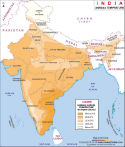 |
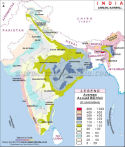 |
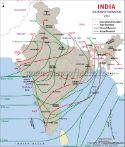 |
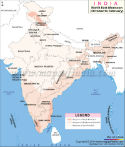 |
| Annual Temperature Map | Annual Rainfall in India | South West Monsoon | North East Monsoon |
Last Updated on : November 13, 2025
General Maps
- National Science Museums in India
- Jyotirlinga Shrines
- Geological Map of India
- Canals in India
- Major Lakes in India
- Heritage Map of India
- Pin Code Zones in India
- Per Capita Income of India
- Major Sea Ports
- Languages in India
- Climate map of India
- Parlimentary Constituencies in India
- Tourist Circuits in India
- Metallic Minerals in India
- Cold Desert Map
- Major Electricity Generator Plants
- Religions In India
- Major Earthquakes in India
- Major Hydro Power Plants
- Indian States and Union Territories
- Cabinet Ministers
- Map of Indian States and Union Territories Enlarged View
- Physiographic Map of India
- Religious Places in India
- Geographical Map of India
- Dams in India
- India Coal Reserves Map
- India Political Map Enlarged View
- India Satellite Map
- Topographic Map of India
- Population Map Of India
- Natural Hazard Map of India
- Tourist Map of India Enlarged View
- Tier I and Tier II Cities of India
- Cyclone Prone Areas in India
- Outline Map of India Enlarged View
- Wine Producing Regions in India
- Map of Major Airports in India
- Birth Rate in India
- Statehood Movements in India
| Buy this Map |
|
|
